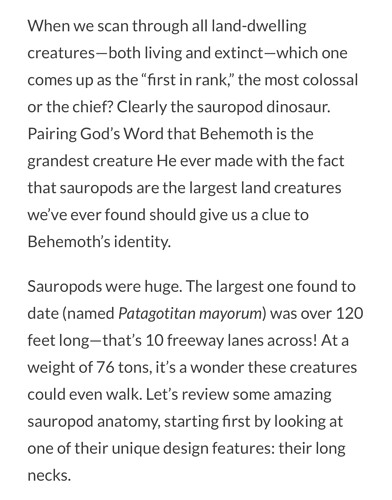I don’t think it’s all that important for everyday Christians to understand how dinosaurs (and their extinction) fit into the biblical creation narrative, even though questions related to them seem to come up more often with today’s generation than past ones.
It’s not a matter that even remotely shakes my faith or is something I desperately need an answer to for me to live my life for Christ, but I certainly would love to have a better response than, “It’s not clearly detailed in the Bible.” I’d love to be able to say something theologically sound, if there is indeed something you might know of that would help me construct a better answer.
I fully understand the Bible is not a blow-by-blow account of every aspect of creation, which would require trillions of pages, would be quite boring and really wouldn’t be much of a faith book; but instead it’s a love letter from God to us, one that provides information critical to our salvation and to our better understanding of who God is and how He wants us to live.
The creation of dinosaurs is not something I thought about — or was even concerned about — when I was young, and it’s definitely not critical to my faith now; yet it has been a question young people have asked me. In fact, many of today’s youth seem to ask a lot of questions about things the Bible doesn’t clearly detail — things many of us older folks (I’m 54) just glossed over because we kind of accepted that God shared the things He wanted to share.
From what I’ve learned, though — and please tell me if there are others not listed below — there are three main ideas:
-
The behemoth spoken of in Job was a dinosaur, so they existed alongside man and were … (see No. 2).
-
… created on the fifth day, along with other animals.
-
The Genesis Gap Theory, where one believes there is a gap between Genesis 1:1 and 1:2, and that dinosaurs and possibly other things were created and then were destroyed (possibly from the fall of the angels, which could have hit Earth like meteorites and consumed the dinosaurs).
I don’t really have a solid opinion on the matter, and I welcome all responses.
My pastor once floated the Gap Theory — as just that: a theory — and I explored the text more in Genesis and found some very interesting things. Mostly, the use of “created” in some instances vs. not saying “created” for other things God did.
Maybe that’s just a translation thing, such as other places in the Bible where two different words technically are the same even though they appear differently. If the different word is meant to be taken differently, “created” would seem to imply ex nihilo, and then some of the other things not listed as “created” could have existed in the gap (the pre-Genesis 1:2 world), and God simply recreated them post 1:2.
Too many to list here, but it’s been argued that (a) God is not credited with “creating” light, but instead it says, “Let there be light” — possibly suggesting light existed between 1:1 and 1:2, and that God “flipped the switch back on” by 1:2, after some unknown cataclysmic event blackened the sky.
I’ve also heard the argument that it’s contrary to God’s nature to create anything that’s “formless and void,” as the text says, because He later said He created all things with a purpose. The argument suggests something happened over millions of years between 1:1 and 1:2 that threw Earth into that void, formless state, thus explaining the very old carbon dating on fossils.
Just a note: I’m fully aware that many are highly opposed to The Gap Theory and believe it is simply the idea of someone who wanted to explain away the questions that have arisen in relation to the carbon dating of fossils.
Lastly, there is that whole “was” or “became” thing in the opening of Genesis, where “Now the Earth was …” is noted with “or became” in the footnotes section. “Became” might add weight to the Gap Theory. Any thoughts on when and why the replacement “became” was added?
As for the traditional view on dinosaurs, if they existed alongside man, (a) when did they go extinct, and why didn’t what caused their extinction also cause man’s extinction; and (b) why isn’t there more than one possible reference to dinosaurs in the Bible (in Job)?
Please be kind in your response, as I’m just trying to learn and I don’t have extensive theological training, as it seems many of you have (I read lots of other posts and replies before I created this topic and was highly impressed with the deep scriptural understanding many of you have).
Thank you.

